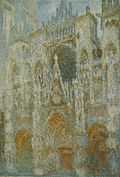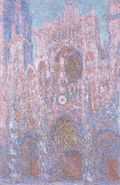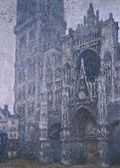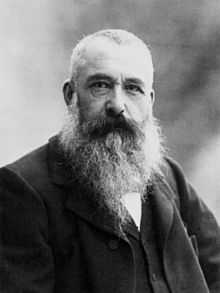Rouen Cathedral (Monet)
 | |
| Artist | Claude Monet |
|---|---|
| Year | 1894 |
| Type | Oil on canvas |
| Dimensions | 107 cm × 73.5 cm (42 in × 28.9 in) |
| Location | Musée d'Orsay, Paris, France |
The Rouen Cathedral series was painted in the 1890s by French impressionist Claude Monet. The paintings in the series each capture the façade of the cathedral at different times of the day and year, and reflect changes in its appearance under different lighting conditions.
Date
The Rouen Cathedral paintings, more than thirty in all, were made in 1892 and 1893, then reworked in Monet’s studio in 1894. Monet rented spaces across the street from the cathedral, where he set up temporary studios for the purpose. In 1895, he selected what he considered to be the twenty best paintings from the series for display at his Paris dealer’s gallery, and of these he sold eight before the exhibition was over. Pissarro and Cézanne visited the exhibition and praised the series highly.
Historically, the series was well-timed. In the early 1890s, France was seeing a revival of interest in Catholicism and the subject was well received.[1] Apart from its religious significance, Rouen Cathedral–built in the Gothic style–represented all that was best in French history and culture, being a style of architecture that was admired and adopted by many European countries during the Middle Ages.
Painting Light
When Monet painted the Rouen Cathedral series, he had long since been impressed with the way light imparts to a subject a distinctly different character at different times of the day and the year, and as atmospheric conditions change. For Monet, the effects of light on a subject became as important as the subject itself. His Series Paintings, in which he painted many views of the same subject under different lighting conditions, are an attempt to illustrate the importance of light in our perception of a subject at a given time and place.
-

Rouen Cathedral, West Façade, Sunlight
1892
National Gallery of Art
Washington, D.C., USA -

Rouen Cathedral,red, Sunlight
1892
National Museum of Serbia
Belgrade, Serbia -

La Cathédrale de Rouen. Le portail et la tour Saint-Romain, plein soleil ; harmonie bleue et or
1892-1893
Musée d'Orsay
Paris, France -

La Cathédrale de Rouen. Le portail, soleil matinal; harmonie bleue
1892-1893
Musée d'Orsay
Paris, France
Robert Pelfrey, in Art and Mass Media (Kendall/Hunt, 1996), says:
- By focusing on the same subject through a whole series of paintings, Monet was able to concentrate on recording visual sensations themselves. The subjects did not change, but the visual sensations – due to changing conditions of light – changed constantly. (166)
The cathedral series was not Monet's first series of paintings of a single subject, but it was his most exhaustive. The subject matter was a change, however, for prior to this series, Monet had painted mostly landscapes. The cathedral allowed him to highlight the paradox between a seemingly permanent, solid structure and the ever-changing light which constantly plays with our perception of it. There were calls for the state to buy the entire series and exhibit them as a whole, but unfortunately these calls were not heeded and the series was divided.
Technique
1892-1894
Musée Marmottan Monet
Paris, France
Painting the cathedral was a challenging task, even for Monet. Michael Howard, in his Encyclopedia of Impressionism (Carlton, 1997), writes:
- As always, the pictures gave him intense difficulties, which threw him into despair. He had vivid nightmares of the cathedral in various colors – pink, blue and yellow – falling upon him… [Monet wrote:] ‘Things don’t advance very steadily, primarily because each day I discover something I hadn’t seen the day before… In the end, I am trying to do the impossible.’ (224).
Monet found that the thing he had set out to paint–light–was, because of its ever-changing nature and its extreme subtlety, an almost impossible thing to capture. He was assisted, however, by his ability to capture the essence of a scene quickly, then finish it later using a sketch combined with his memory of the scene. For these paintings, he used thick layers of richly textured paint, expressive of the intricate nature of the subject. Paul Hayes Tucker, in Claude Monet: Life and Art (Yale University Press, 1995), writes:
- Monet’s sensitivity to the natural effects he observed are just one factor that make these pictures so remarkable; the way he manipulates his medium contributes to their majesty as well. For the surfaces of these canvases are literally encrusted with paint that Monet built up layer upon layer like the masonry of the façade itself. (155)
The subtle interweaving of colors, the keen perception of the artist and the use of texture all serve to create a series of shimmering images in light and color–masterpieces worthy of the grandeur of their subject matter.
Gallery
-

The Portal of Rouen Cathedral in Morning Light, 1894, J. Paul Getty Museum.
-

The portal and the tower of the saint-romain at morning sun, Harmony in Blue
1893
Musée d'Orsay
Paris, France -
Rouen Cathedral, Facade (Morning effect)
1892-1894
Folkwang Museum
Essen, Germany -

Rouen Cathedral, Facade 1
1892-1894
Pola Museum of Art
Hakone, Japan -

Rouen Cathedral, The Façade in Sunlight
1894
Clark Art Institute
Williamstown, USA -
Rouen Cathedral, West Facade, 1894, National Gallery of Art
-
Rouen Cathedral, West Facade, Sunlight, 1894, National Gallery of Art
-

Rouen Cathedral- Setting Sun, (Symphony in Grey and Pink), 1894, National Museum Cardiff, Great Britain
-

Rouen Cathedral, Facade and the Tour d'Albane. Grey Weather, 1894, Musée des Beaux-Arts de Rouen
-

La Cathédrale de Rouen. Le portail et la tour Saint-Romain, effet du matin ; harmonie blanche
1892-1893
Musée d'Orsay
Paris, France -
Rouen Cathedral, Facade and Tour d'AlbaneI, dull day
1892-1894
Beyeler Museum
Riehen, Switzerland -

Rouen Cathedral, the West Portal, Dull Weather
1892
Musée d'Orsay
Paris, France
References
External links
|
| |
|
|
![]() Media related to Claude Monet at Wikimedia Commons
Media related to Claude Monet at Wikimedia Commons
![]() Media related to Rouen Cathedral by Monet at Wikimedia Commons
Media related to Rouen Cathedral by Monet at Wikimedia Commons
- An in-depth analysis of Monet's Rouen series in theartwolf.com
- Brief essay on Monet's Rouen Cathedral series from the J. Paul Getty Museum




